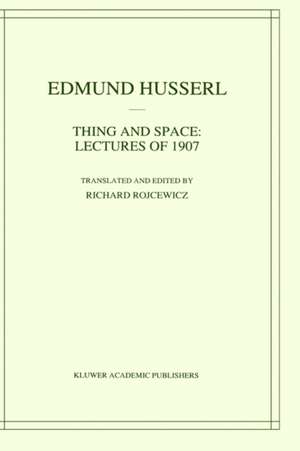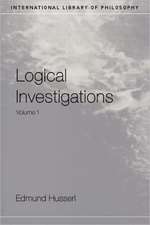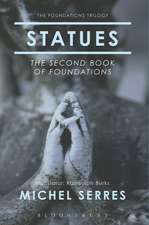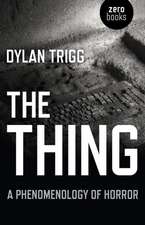Thing and Space: Lectures of 1907: Husserliana: Edmund Husserl – Collected Works, cartea 7
Autor Edmund Husserl Traducere de R. Rojcewiczen Limba Engleză Hardback – 31 oct 1997
| Toate formatele și edițiile | Preț | Express |
|---|---|---|
| Paperback (1) | 393.13 lei 6-8 săpt. | |
| SPRINGER NETHERLANDS – 28 oct 2010 | 393.13 lei 6-8 săpt. | |
| Hardback (1) | 402.17 lei 6-8 săpt. | |
| SPRINGER NETHERLANDS – 31 oct 1997 | 402.17 lei 6-8 săpt. |
Preț: 402.17 lei
Nou
Puncte Express: 603
Preț estimativ în valută:
76.96€ • 83.57$ • 64.65£
76.96€ • 83.57$ • 64.65£
Carte tipărită la comandă
Livrare economică 22 aprilie-06 mai
Preluare comenzi: 021 569.72.76
Specificații
ISBN-13: 9780792347491
ISBN-10: 0792347498
Pagini: 350
Ilustrații: XXXII, 350 p.
Dimensiuni: 156 x 234 x 27 mm
Greutate: 0.75 kg
Ediția:1998
Editura: SPRINGER NETHERLANDS
Colecția Springer
Seria Husserliana: Edmund Husserl – Collected Works
Locul publicării:Dordrecht, Netherlands
ISBN-10: 0792347498
Pagini: 350
Ilustrații: XXXII, 350 p.
Dimensiuni: 156 x 234 x 27 mm
Greutate: 0.75 kg
Ediția:1998
Editura: SPRINGER NETHERLANDS
Colecția Springer
Seria Husserliana: Edmund Husserl – Collected Works
Locul publicării:Dordrecht, Netherlands
Public țintă
ResearchCuprins
Thing and Space. Lectures of 1907.- Section I The Foundations of a Phenomenological Theory of Perception.- 1. Fundamental Determinations of Outer Perception.- 2. The Methodological Possibility of the Analysis of Perception.- Section II Analysis of Unchanged Outer Perception.- 3. The Elements of Perceptual Correlation.- 4. The Constitution of the Temporal and Spatial Extension of the Appearance.- Section III Analysis of the Kinetic Synthesis of Perception. Changes in Perception and Changes in Appearance.- 5. The Givenness of the Thing at Rest in Continuous Courses of Perception.- 6. The Possibility and Sense of an Adequate Perception of Spatial Things.- 7. Recapitulation. the Analyses of Perception in The Framework of the Phenomenological Reduction.- Section IV The Significance of the Kinaesthetic Systems for the Constitution of the Perceived Object.- 8. The Phenomenological Concept of Kinaesthesis.- 9. The Correlation Between the Visual Field and the Kinaesthetic Sequences.- 10. The Thing as Unity in the Kinaesthetically Motivated Manifold of Appearances.- Section V The Transition from the Oculomotor Field TO Objective Space. the Constitution of Three-Dimensional, Spatial Corporeality.- 11. Amplifications of the Oculomotor field.- 12. The Typicality of the Modifications of Appearances in the Oculomotor Field.- 13. The Constitution of Space Through the Conversion of the Oculomotor Field Into an Expansional and Turning Manifold.- 14. Supplementary Considerations.- Section VI The Constitution of Objective Change.- 15. Qualitative Changes of the Perceptual Object.- 16. The Constitution of Mere Movement.- Final Consideration.- Supplementary Texts.- A. Essays.- I. Systematic Constitution of Space. Husserl’s Draft.- A. Sense-fields and kinaesthetic systems.- B. Levels of theconstitution of space.- II. Systematic Constitution of Space. Edith Stein’s Elaboration.- §1. Necessity of a location for each body.- §2. Sense-fields and kinaesthetic field.- §3. The significance of the various kinaesthetic systems for the constitution of space.- §4. Significance of kinaesthetic sequences for the constitution of Objective rest and movement.- §4a. I am moved; my body.- §5. Null-orientation of the kinaesthetic systems.- §6. Basic distinction within the kinaesthetic systems and within the constitution of space. Closed visual space and infinite Objective space.- §7. Further distinctions in the kinaesthetic systems and in the constitutive levels.- §8. The pre-eminence of the null-position. The optimum of the visual field.- §9. Interrelations among the kinaesthetic systems in question.- B. Appendices.- Appendix I: Husserl’s Critical Remarks on the Course of Thought and the Progression of the Lectures, Compiled by the Editor.- Appendix II (to §1): On the Doctrine of the Levels of Givenness of Things.- Appendix III (to §§20FF.); The Special Position of the Spatial Feature (Determination of Space).- Appendix IV (to §§49FF.): The Kinaesthetic Systems of Monocularity and Binocularity.- Appendix V (to §54): Strata in the Constitution of the Thing.- Appendix VI (to §54): Motivational Nexuses and Apperception.- Appendix VII (to §76): Empty Space.- Appendix VIII (to §78): Problem of the Quality That Fills Space.- Appendix IX (to §§82F.): On the Constitution of Movement and Rest.- Appendix X (to §83): Subjective Self-Movement AND Objective Corporeal Movement.- Appendix XI (to §83): Visual Space and Objective Space.- Appendix XII (to Essay I): On the Constitution of Riemannian Things.- Appendix XIII (to Essay II, §4A): Active and PassiveLocomotion.




























